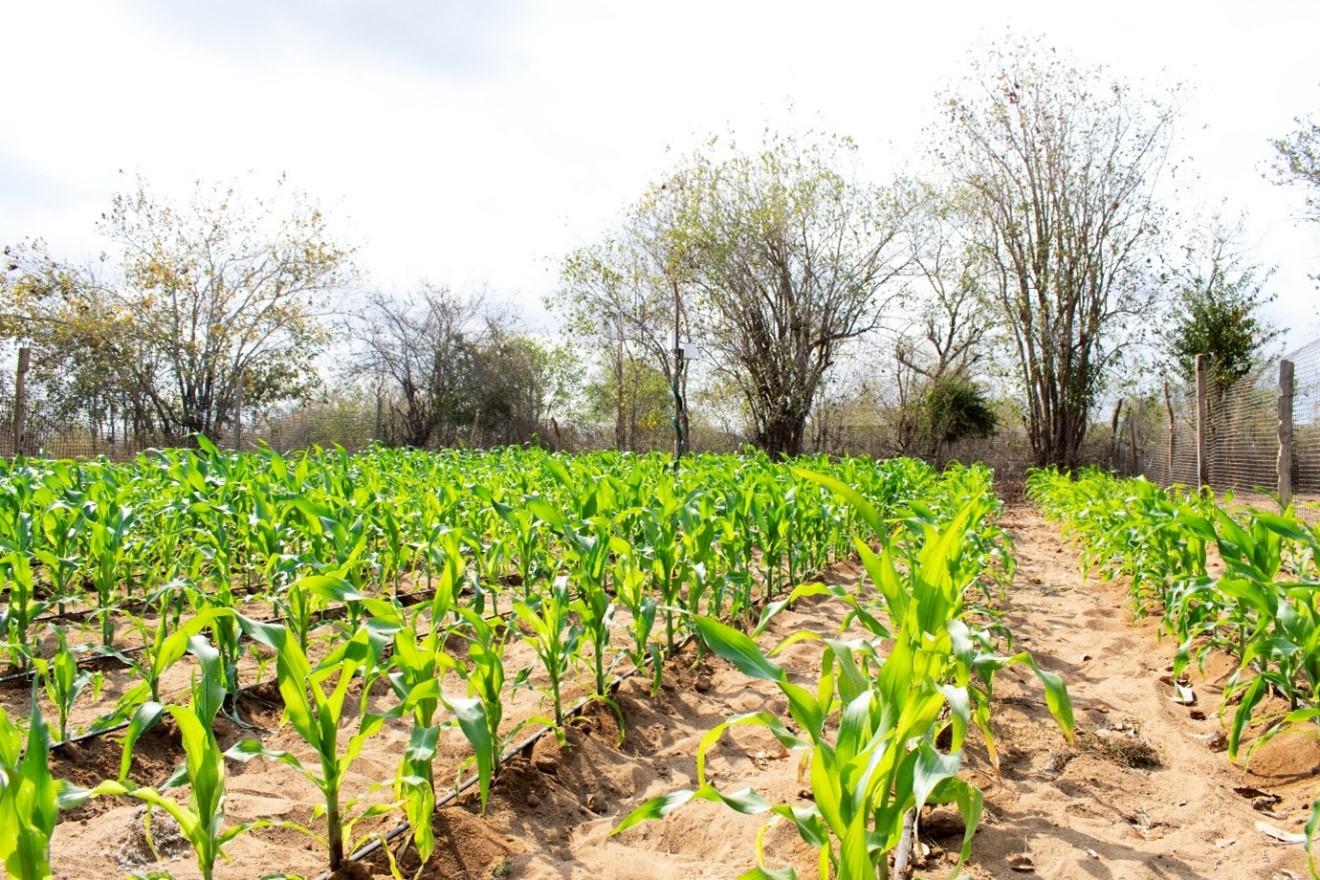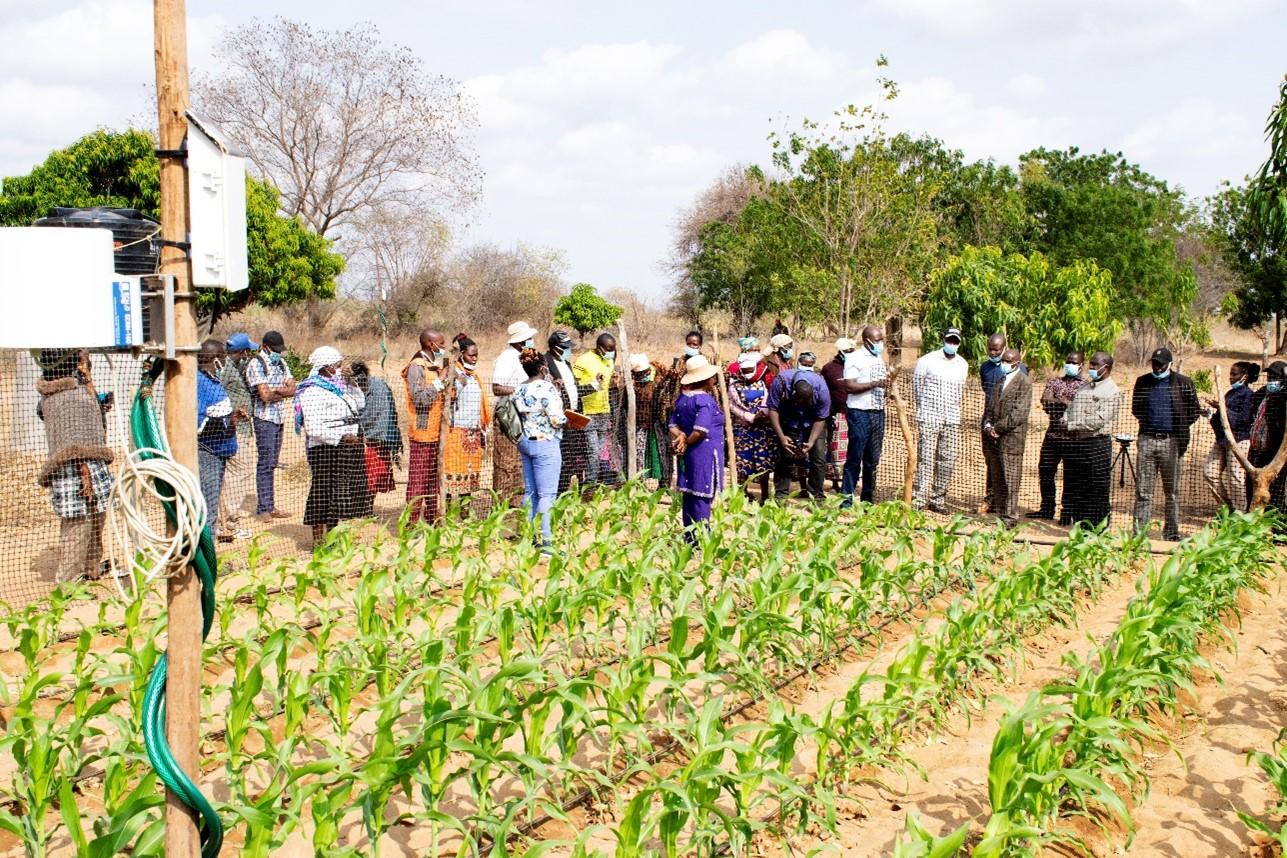Blog Making sandy soils agriculturally productive, land-case Makueni County, Kenya

Maize on sandy soils in Ulilinzi, grown during the dry season under drip irrigation.
©Denet Odhiambo, Bungu Visuals
Making sandy soils agriculturally productive land with financial support from the Nordic Development Fund through its Nordic Climate Facility. Jomo Kenyatta University of Agriculture and Technology (JKUAT), JKUAT Enterprises Ltd (JKUATES), The Alliance of Bioversity International and International Center for Tropical of Agriculture (Alliance Bioversity-CIAT), Swedish University of Agricultural Sciences (SLU), and SWRT Solutions LLC., have carried out a project to increase farm system resilience, crop production and carbon accumulation in sandy soils.
Soil water retention membranes were installed in 19 farms in Makueni and have so far proved effective in maintaining the growth and yield of crops under low and unreliable rainfall. A stakeholder workshop and field day held on 29-30th July 2021 validated Subsurface water retention technology (SWRT) as one of the most effective technologies for combating climate-related risks among smallholder farmers in Makueni.
Multiple challenges limit productivity of crops grown on sandy soils which are not fertile and only have little capacity to hold water and retain nutrients. Water rapidly moves down the soil and fertilizer is easily leached below crop roots after application. As a result, farmers eschew irrigation or fertilizer application. The few who do, get very little benefits from supplemental irrigation or the use of fertilizers. Sandy soils also become compact during the dry season, making it difficult to cultivate. This is caused by presence of very low organic matter, clay content and soil moisture. Farming on sandy soils using conventional practices has proven difficult for most farmers.
Sandy soils are plenty in arid and semi-arid areas, where water deficiency is a major constraint for agricultural production. The areas are characterized by low, infrequent, and unpredictable rainfall, and extremely high temperatures. This exposes smallholder farmers who eke out a living by farming to frequent crop failure, reduced yields, and limited alternatives livelihood. Farmers in Makueni are particularly vulnerable. Agricultural production on sandy soils, therefore, requires interventions that build the resilience of farming systems, for example by increasing their capacity to hold water, retain nutrients and temper microclimate.
SWRT is one of the technologies that has been championed as having potential for increasing productivity of sandy soils. The technology involves installation of engineered impermeable U-shaped polymer membranes that retain much of the water added to the soil surface by rainfall or irrigation for prolonged periods, and that prevent loss of nutrients through water percolation. Demonstrations in Makueni show that installation of SWRT membranes in sandy soils can increase crop yield and biomass production as shown by the photo below. This holds benefits for both food security and climate protection, especially if the biomass produced is retained or returned to the field as animal manure. SWRT can also diversify production systems thus increasing improving diets.

Photo 2: Lean maize grown on sandy soil without SWRT membrane (left) compared to lush maize grown on sandy soil with SWRT membrane (right) during the October-January 2021). SWRT membranes are buried in the soil at alternating (60 and 40 cm) depths with gaps that allow excess water to drain and roots to circumvent the membrane. The membranes can stay in the soil for many (>50) years and do not require maintenance.
When combined with irrigation, SWRT can minimize risks of crop failure and allow crop production during the dry season. Makueni receives bimodal rainfall (long rain: March-May; short rains: Nov.-Dec.) that is supposed to support two cropping seasons. Long rains are however unpredictable and often fail to occur, rendering the region a one-season cropping area. Farmers mainly rely on the short season for subsistence production. Installation of SWRT membranes, combined with irrigation can diversify production, permit a three-season cycle which will allow the production of high-value crops. Irrigated SWRT can eliminate incidences of crop failure and reduce the amount of water used for irrigation. A current demonstration in Makueni is testing SWRT under irrigation as illustrated by photo 1.

Photo 1. Five weeks maize (planted on 24/06/2021) on sandy soils in Ulilinzi, grown during the dry season under drip irrigation.
©Denet Odhiambo, Bungu Visuals.
A stakeholder workshop and a field day, held on 29-30th July 2021, provided a platform for connecting stakeholders within the project and in the food value chains. The workshop brought together producers (farmers and farmer groups), input (seed) suppliers, extension officers, advisory providers, researchers, local administration, county representatives, national government representatives, insurance providers, agricultural technology, non-governmental organizations, communication and dissemination personnel. This workshop informed stakeholders about SWRT technology, its merits and business opportunities. At the same time the stakeholders understood how they can contribute to the uptake of the technology and the business around the technology. SWRT is described as one of the most effective technologies for combating climate-related risks among smallholder farmers. A cost-benefit is being done to weigh up the costs of installation and identify scenarios that will give the greatest benefits to farmers and stakeholders.

Photo 3. Stakeholders admire irrigated maize grown during the dry season in Ulilinzi, Makueni.
©Denet Odhiambo, Bungu visuals
Stakeholder Opinions
Project team: Shem Kuyah (JKUAT), Winifred Karugu (JKUATES), Sylvia Nyawira and Stanley Karanja (The Alliance Bioversity-CIAT), Alvin Smucker (SWRT SOLUTIONS Ldt) and Libère Nkurunziza (SLU).
For further information, please contact Sylvia Nyawira
